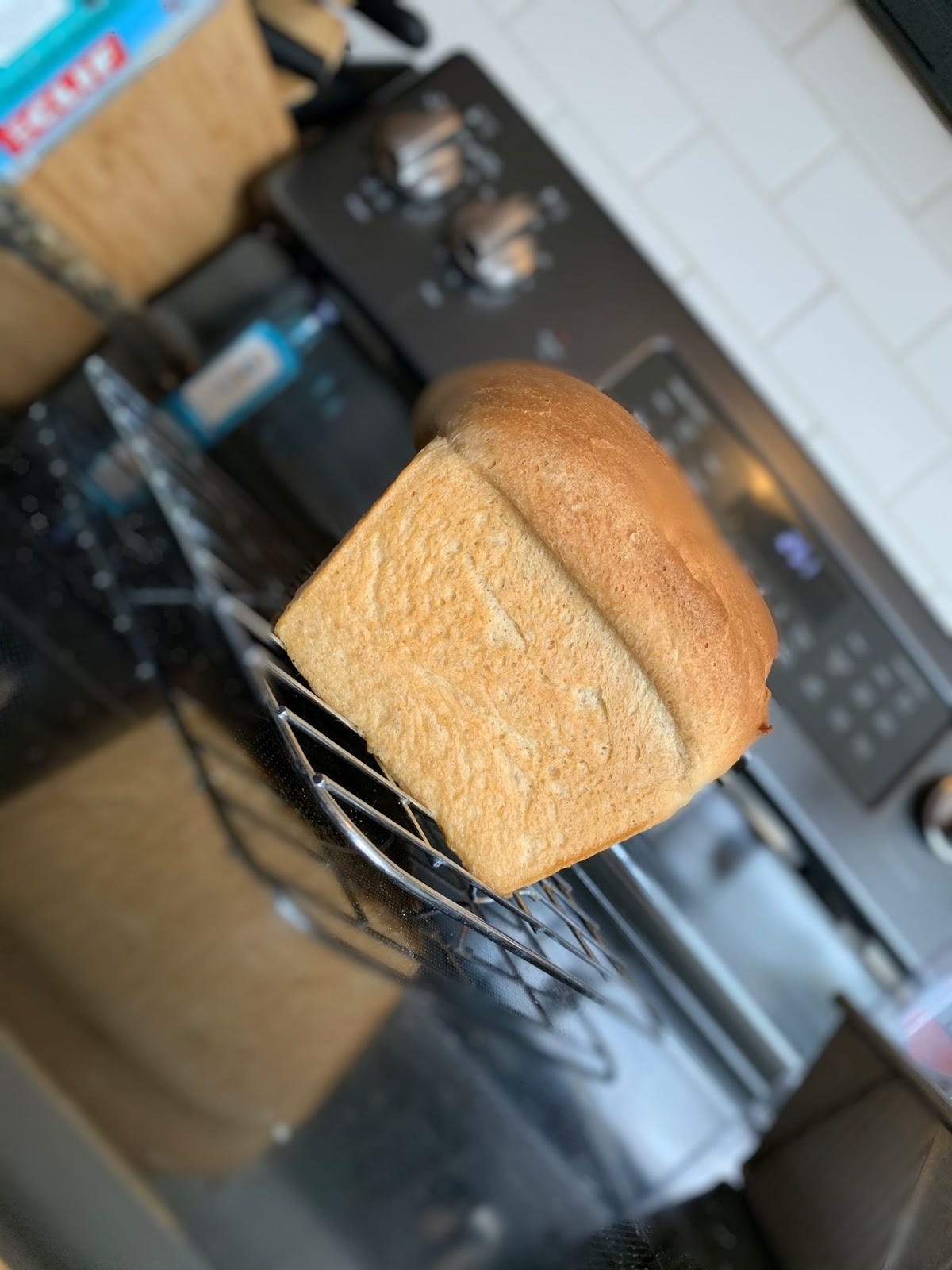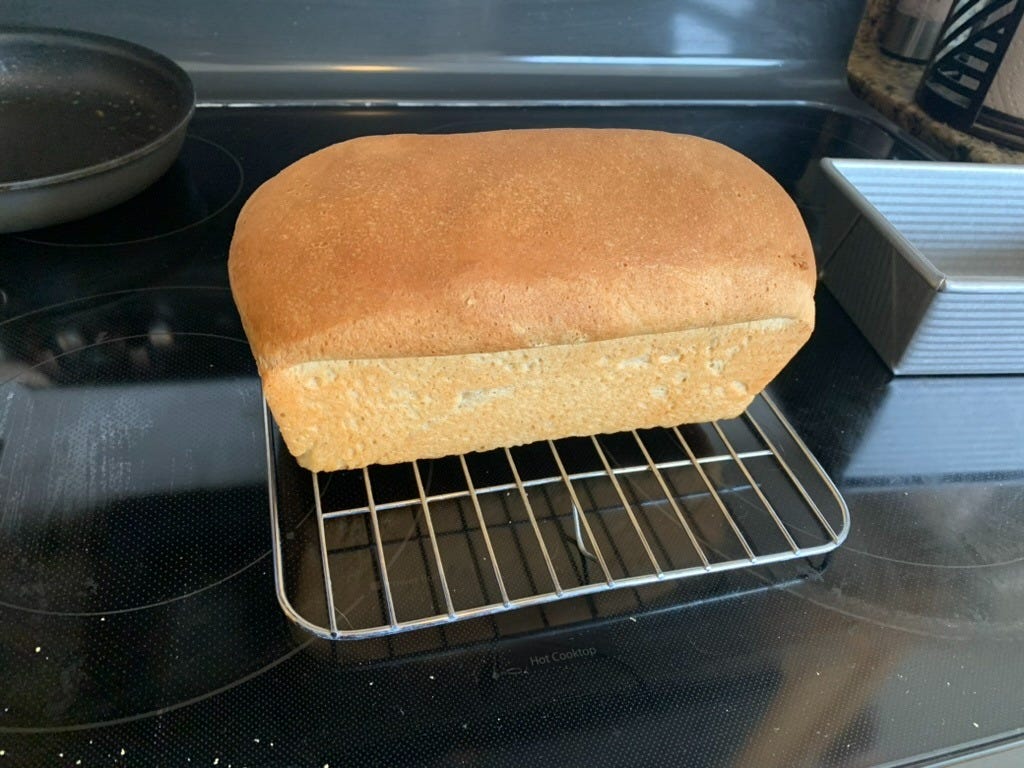My Bread Has a Depression (and That’s Fine)
Special guest writer Alexander Lovell, PhD, on Befriending Imperfect Loaves.
Hello dear reader! Today you’re in for a treat. I’m thrilled to introduce Alexander Lovell, PhD—Dr. A, as I call him—a political psychologist, yoga therapist, and writer who brings hard-won wisdom to everything he creates. He’s navigated homelessness, survived a seven-car pileup with a semi, lived through divorce, and emerged with both humor and heart intact. After you read today’s piece, I hope you’ll visit his Substack, “Life as I See It,” or explore his website to discover more of his work.
I used to bake beautiful bread.
Influencer-worthy loaves with golden crusts that crackled when you broke them open. Interiors with those irregular holes that whisper “artisan.” The kind of bread that made people pause and whisper with wonder… “You made this?”
That was before my brain broke.
Now I pull loaves from my oven that look like they’ve given up on life. Sunken middles. Deflated centers. Every single time. Fifty loaves since I switched to home-milled flour, and every single one has emerged with what I can only describe as a depression.
The bread has a depression. I’m not saying I have a depression. Though after a brain injury that required me to overhaul everything about how I eat, including this absurd prescription to mill my own flour for the nutritional density my recovering brain apparently needed, let’s just say I understand the bread on a spiritual level.
A Prescription Out of Left Field
“You should mill your own flour.”
My doctor said this as casually as if she’d suggested I drink more water.
I stared at her. “I’m sorry, what?”
“Home-milled flour. The nutrition degrades rapidly after milling. Fresh-milled is better for brain health.”
I wanted to ask if she was secretly a lifestyle blogger from 2019. She wasn’t joking. She was looking at my charts, at my brain that had betrayed me, telling me that if I wanted to give it the best chance at healing, I needed to become the kind of person who owns a grain mill.
So I bought a grain mill.
$300. It sits on my counter like a small, judgmental appliance, waiting for me to spend three hours every week making bread that looks like it needs therapy.
Here’s what my doctor didn’t tell me: home-milled flour bakes nothing like all-purpose flour. It’s denser, thirstier, more temperamental. I can bake beautiful bread with all-purpose flour—past tense feels wrong because the skill didn’t leave, the option did. Home-milled whole wheat flour? Different language. I’m still stumbling through basic phrases.
The Loaf That Almost Broke Me
Four months in, there was a loaf that made me seriously consider just accepting whatever inflammatory consequences came with regular bread.
I’d spent the entire afternoon on it. Hand-milled the flour. Mixed, kneaded, waited through the first rise. Shaped it carefully, let it proof. Slid it into the oven with something close to hope.
When I pulled it out, the center had collapsed so dramatically it looked like a crater. Like the bread had experienced its own small apocalypse.
I stood there holding the pan, tears starting. Not because of the bread—or not just because of the bread. Because everything since the injury had been like this: trying so hard, doing everything “right,” and still ending up with something that didn’t look the way it was supposed to.
I put the bread on the cooling rack and walked away.
An hour later, I came back and sliced into it anyway. What else was I going to do? I’d spent three hours making it, and my brain needed the nutrition.
It was delicious.
Flat as a pancake in the middle, sure. But the flavor was nutty and complex, the texture pleasantly chewy. It made exceptional toast. My partner ate three slices and asked when I’d make more.
The bread didn’t care that it looked wrong. It was still bread. It still nourished.
The Slow Rise
Here’s something I didn’t expect: the bread IS getting better.
Not perfect. Not I’m-going-to-be-on-master chef.
But better.
Last week’s loaf had less of a crater. More of a gentle dip. The week before that, the center held just a little higher. I’m learning things: how this particular flour wants to be treated, how much water it actually needs, when to keep kneading even though my hands want to stop.
The improvement is so gradual I almost missed it. Like healing. Like recovery.
You don’t wake up one day cured. You don’t pull a perfect loaf from the oven after fifty failures and declare victory. It’s subtler than that. Slower.
One day you realize you got through an entire afternoon without succumbing to a migraine. One day you notice the bread has something that almost resembles a dome. Not much of one. But something.
Time. Patience. Presence.
I’m learning to enjoy the process instead of just tolerating it while I wait for better results. The smell of fresh-milled flour. The feel of dough under my hands. The weird satisfaction of pulling out a loaf that’s slightly less depressed than last week’s.
And butter helps. A lot of butter.
When the bread is warm and you slather it with good butter, the fact that it’s flat becomes almost irrelevant. The flavor is there. The nourishment is there. The evidence that I showed up this week is there.
I’m getting better. The bread is getting better. We’re both still imperfect, but we’re both rising. Just slowly. Just a little at a time.
There’s still a moment, every single time I open the oven, when I brace for disappointment. Old habit. But now there’s also curiosity: How did this one turn out? Is it better than last week?
The bread isn’t perfect. It’s not even conventionally good-looking. But it’s good enough. And week by week, it’s getting a little better. A little more dome-like. A little closer to what I remember.
I’m not writing this to tell you that imperfection is beautiful or that you should embrace your flaws or any of those worn-out platitudes that sound nice but feel hollow when you’re actually living inside the gap between what you hoped for and what you got.
I’m writing this because I have a bread depression, and I’m watching it slowly heal. I had a brain injury, and I’m watching myself slowly heal too. Life kept going even when it stopped looking the way I planned, and I had to figure out how to keep going with it.
The bread rises the way it rises. My life unfolds the way it unfolds. Both are getting better, just not on any timeline I would have chosen.
That’s not resignation.
That’s aliveness. Misshapen, improving, nourishing aliveness.
And honestly, with enough butter? It tastes pretty damn good.
A note from Ilona:
What I love about this piece is the honesty—about bread, about brains, about the gap between what we thought we’d be making and what actually emerges. Dr. A has learned what all good bakers eventually discover: imperfection doesn’t ruin the loaf. It just makes it yours.
If this resonated with you, please like, comment, and restack—it means the world to guest writers to know their words landed. And if you have your own imperfect loaf story, I’d love to hear it in the comments.
P.S. Butter fixes everything. This is not a metaphor.
If you’d like to hear more from Dr. A, subscribe below.





Great piece by Dr. A. I could almost taste the bread that he was describing. This week's post was possibly the best thing since sliced...err, well, you know. And I'm a pretty tough critic because I'm New Jersey-born-and-bread... OK, OK, I'll stop here with the puns before everyone gets crusty. But seriously, this post about bread was Wonder-ful!
I think for me was the fact that practically every mother I knew didn't bake bread and I wanted to fit in with the other kids because they were all eating store-bought bread and it look more dainty? than a thick piece of bread in a lunch box. Crazy, I know. Thanks for your reply.